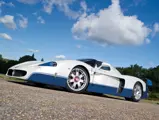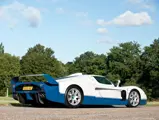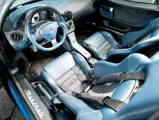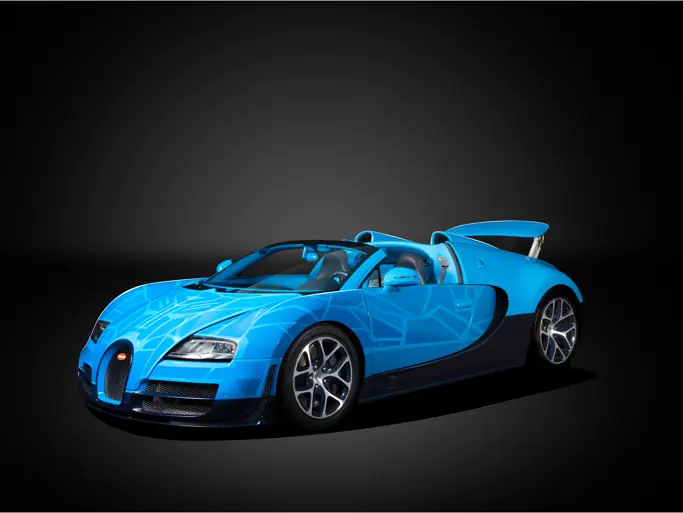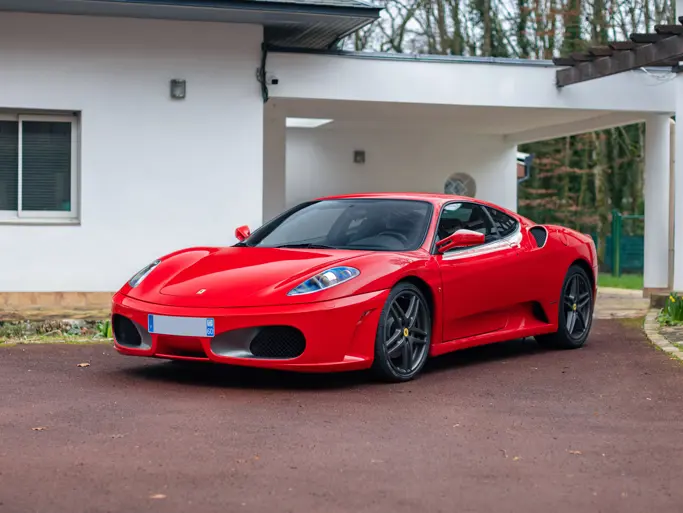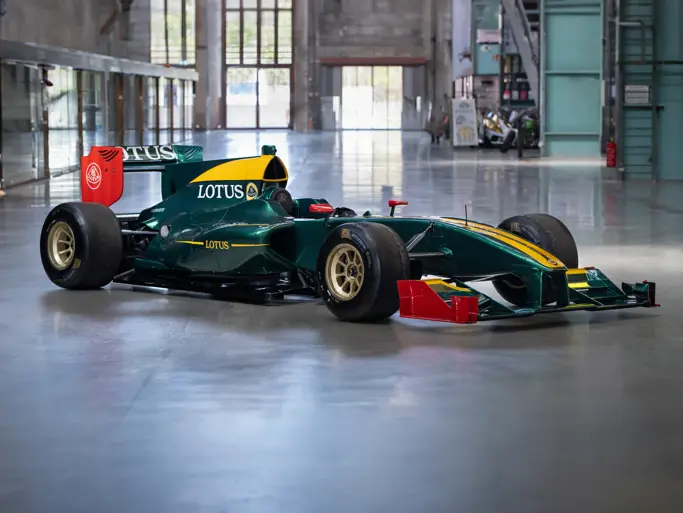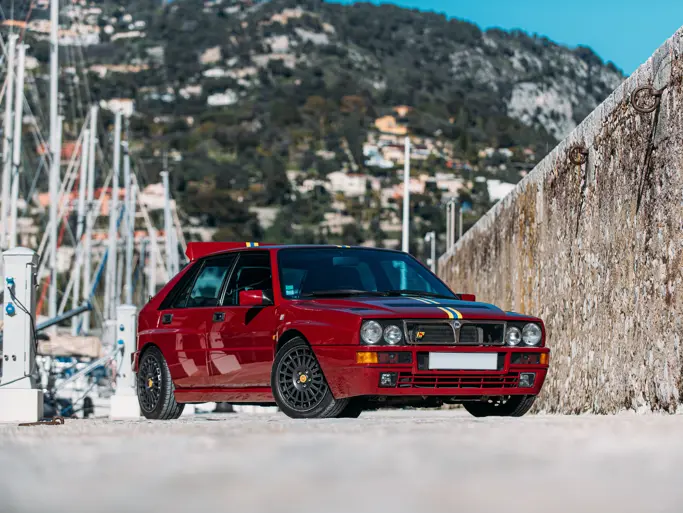London 2012
2005 Maserati MC12
{{lr.item.text}}
£680,000 - £780,000 GBP | Not Sold
 | London, United Kingdom
| London, United Kingdom
{{internetCurrentBid}}
{{internetTimeLeft}}

620 bhp, 5,998 cc 65 degree-V twelve-cylinder engine, six-speed flappy-paddle Maserati Cambiocorsa transmission, front and rear independent adjustable wishbone suspension, and four-wheel cross drilled ventilated disc brakes. Wheelbase: 110.2 in.
• Ultra exclusive; one of only 50 built from 2004–2005
• Zero to 60 in 3.8 seconds; top speed in excess of 205 mph
• Two owners from new with only 2,500 km
The Trident has graced the face of some of the most venerated automobiles for race and road since the brothers, Alfieri and Ettore Maserati, built their first car in their small workshop in Bologna, Italy in 1926. Older than Ferrari and Lamborghini, Maserati was the dominant force in international auto racing for decades, feared and revered by all. Through mismanagement and unfortunate circumstances, its place at the crown of Italian motorsports would eventually become a distant memory. In the early-1990s, under the ownership of Fiat, the company faded away.
Ferrari acquired Maserati in 1997, determined to sharpen the Trident and rebuild the company’s image. To accomplish this, Maserati was in need of a halo car, a tangible symbol of the new Maserati, one that would pay homage to the cars that dominated race tracks around the world, cars like the 450s and the Tipo 60/61. The FIA GT Championship series was chosen to be the venue where Maserati would attempt to win its first victory in an international championship since the Cooper Maserati Formula One car won the South Africa Grand Prix in 1967.
Homologation rules required a run of 25 cars, and Maserati planned to match that number both years of the 2004–2005 production run. Using the Ferrari Enzo as the platform for the MC12, a halo car, Maserati was guaranteed. American Frank Stephenson, Director of Concept Design and Development at Maserati, worked closely with wind tunnel engineers in forming the design of the car. The car’s general dimensions recall the Group C Le Mans cars of the 1980s, with the Enzo wheelbase lengthened half a foot and the overall length increased 17.5 inches. Not only does this added length increase high-speed stability, much of it is transferred into the passenger compartment, making the car a better fit for taller drivers.
Also borrowed from the Enzo is the naturally aspirated dual-overhead cam six-litre 12-cylinder engine, which aside from producing one of the most wonderful mechanical songs, develops 630 brake horsepower and 481 foot-pounds of torque at full tune. With a curb weight of 2,943 pounds, the MC12 boasts a 0–60 time of 3.8 seconds and a top speed in excess of 205 mph. All the power is harnessed by Maserati’s own Cambiocorsa six-speed transmission. Fully computerized, the driver selects gears via paddles located behind the steering wheel. The car performs with seamless upshifts and perfect double-clutch downshifts, blipping the throttle automatically to match revs, in essence, making a poor or miss-shift impossible. With either sport or race modes to select from, the MC12’s transmission is capable of lightning fast aggressive shifts on the track, as well as delivering the road manners for which Maserati’s latest generation of road-going cars are famous. Also, to assist with regular drivability, the front of the car can be raised at low speeds with the push of a button to clear moderate bumps and inclines.
Throwing modesty out the door, the MC12’s ability to take one’s breath away was a prerequisite established by the Maserati brass. Like a great race car, this form following function, purpose-built machine is intoxicating to the purist’s senses. To fully accomplish its mission as the ultimate Maserati, certain signature elements were incorporated into the design to make the car both immediately recognizable and to secure its place in automotive history as one of the most beautiful cars. Viewed from the front, the eye is immediately drawn to the bonnet, where, just inboard of the wheel arches, organically shaped ribs are tautly stretched across the functional apertures. However, the MC12 looks particularly striking when viewed from the rear three-quarters: the architectural half-moon arch-like shape of the rear wing stands tall and wide, above the black engine louvers and the suggestive quad-exhausts and the enormous carbon-fiber diffusers. With the perfect harmonizing race car and rolling sculpture, Maserati’s visual appeal is arresting.
The 50 road versions of the MC12 that were produced over the two year run were all identical, even finished in pearl white over blue as a tribute to the America Camoradi Scuderia, which raced the famous Maserati Tipo 60-61 Birdcages in the very early-1960s, with Stirling Moss as their lead driver. The body of the MC12 is constructed entirely of carbon fibre, with the stressed chassis made of carbon fibre and Nomex sandwiched in a honeycomb configuration. The cabin of the Maserati has a removable top, which converts the supercar from coupé to spider. The interior was designed with the driver in mind, with everything perfectly located, making the driving experience intuitive, yet there is meticulous care evident in the fit and finish, always reminding the occupants that they are in a Maserati. With clean, tailored lines, materials of the finest quality, and special attention paid to comfort, the MC12 perfectly marries luxury with race car.
Practically every MC12 constructed in 2004 and 2005 were sold before being built. They each boasted a sticker price of $799,000 and were ushered out of the Modena factory into the stables of some of the most enviable sports car collections in the world. This example has had two owners in its lifetime and has been driven only 2,500 kilometres since being released. Without incident, this marvel has always been properly maintained by the Ferrari Maserati main dealer and is currently up to date, having been serviced this year. An opportunity such as this is unlikely to present itself again in the near or even distant future. Ever exclusive, the new owner is sure to be a proud member of the Maserati elite.

